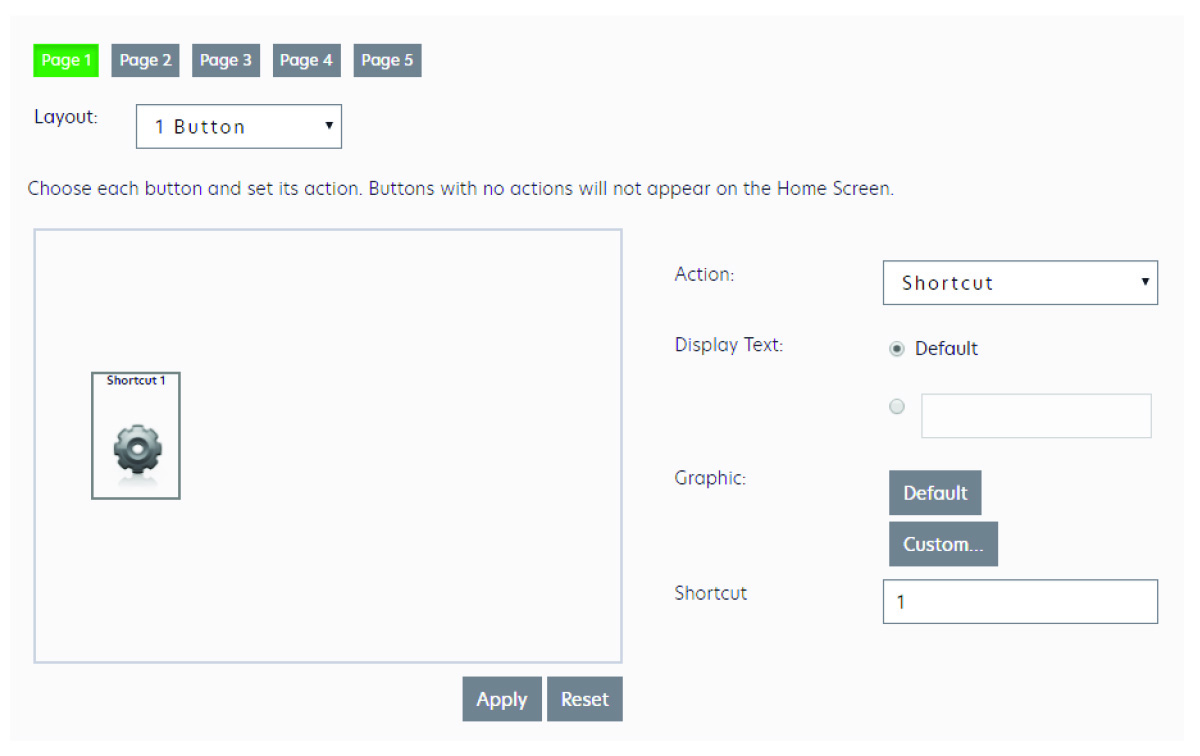From LMC, click the Device Groups tab.
From the Device Groups section, select a device group.
From the Tasks section, select Home Screen.
Click the tab for each device class that you want to customize.
Select Use this home screen as part of the device groups policy.
Configure the settings.
For touch-screen printers, do the following:
In the Layout menu, select the number of buttons to include.
If necessary, select a page, and then select a button.
In the Action menu, select an action for the button.
Notes:
- Make sure to select an action for all the buttons that you want to appear on the home screen.
- If you have customized the home screen in your previous sessions, then reset the actions of the buttons on all pages before applying the new settings. Standard functions such as copy, fax, and e-mail do not automatically appear on the home screen. For these functions to appear on the home screen, assign an action.
- In e-Task 5+ printers, for the home screen customization icon to arrange the application on the printer, it can be a group of 4 or 8 on Page 1 and other pages.
Function
Available selections1
1 Some selections may not be available in some models.
2 A standard function overrides itself when configured with a profile. For example, Copy + Profile executes the same function as Copy.
3 LMC cannot access eSF application icons directly. To provide locations for eSF application icons in the default order, use placeholders. To designate a location for the icon of an eSF application identified by name and set the profile name of the application, use App Reservation. For example, the profile name for the Scan to Network application is . If placeholders or App Reservations are not provided, then installed eSF applications appear on the first page after the pages defined in the custom home screen.
Execute a standard MFP function.
Address Book
Bookmarks
Change Language
Copy
Copy Shortcuts
Email
Email Shortcuts
Fax
Fax Shortcuts
FTP
FTP Shortcuts
Held Faxes
Held Jobs
Jobs by User
Job Queue
Lock Device
Printer Panel
Release Held Faxes
Scan Profiles
Search Held Jobs
Settings
Shortcuts
Status or Supplies
USB Drive
Show a list of profiles.
App Profiles
Profiles
Execute a specific profile.
Single Profile
Override a standard function with a profile.2
Copy + Profile
Email + Profile
Fax + Profile
FTP + Profile
Execute a printer shortcut.
Shortcut
Provide a placeholder for an eSF application icon.3
App Reservation
Placeholder
Leave a blank space.
None
If necessary, specify the details of the action. Do any of the following:
If you selected Shortcut, then enter the number of the shortcut.

Notes:
- Shortcuts added in LMC are device-class shortcuts, and not eSF-application-specific shortcuts.
- When updating the shortcut number of a profile, make sure to match it with the shortcut number in the Home Screen settings.
If you selected Single Profile or if you are overriding a standard function with a profile, then select a profile.
If you selected App Reservation, then type the profile name of the eSF application that uses the button.

If necessary, type a custom text.
Note: You cannot set a custom text for Placeholder or App Reservation.The graphic that appears on the button is the default graphic of the action. If you want to select a custom graphic for any action except Placeholder or App Reservation, then do the following:
Click Custom.
Click Change, and then browse to a JPEG, GIF, or PNG file for the Up and Down icons.
Click Upload > Apply.
Note: If you want to revert to the default graphic, then click Default.
The images that you selected are resized automatically to the following dimensions for each device class. For best results, resize or crop source images to the correct size before uploading.
e-Task 5—140 x 140 pixels
e-Task 4—172 x 254 pixels
e-Task 3—172 x 254 pixels
e-Task 2+, e-Task 2, and SFP e-Task 2+—120 x 75 pixels
e-Task—120 x 80 pixels
X642—120 x 55 pixels
Note: For a list of supported printers in each device class, see Supported printer models.
For non-touch-screen printers, do the following:
In the Layout menu, select Custom.
Following the list of buttons, click Add.
Notes:
- The only action available is Single Profile. You cannot modify other menu items on a printer without a touch screen.
- To remove a button, select it in the list, and then click Remove.
If necessary, type a custom text.
Select a profile to associate with the button.
Configure the remaining buttons on the home screen.
Click Apply.